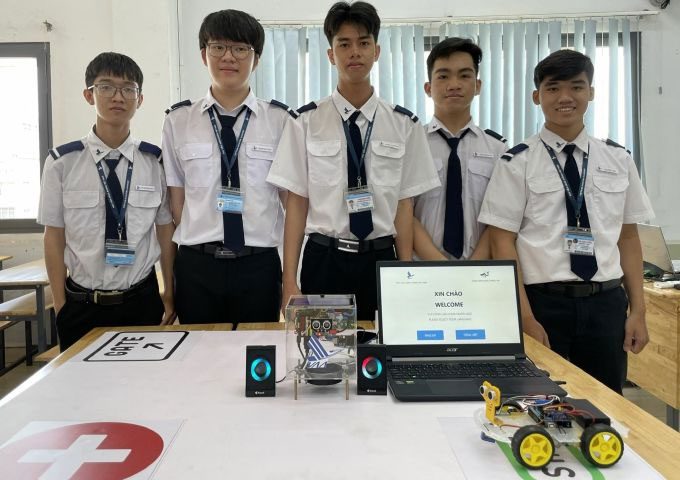A group of students from the Vietnam Aviation Academy has developed a device box designed to be placed in various locations within airports to assist passengers in finding boarding gates, restrooms, and accessing information.
Starting in early 2024, the student team, including Tran Quang Tin, Nguyen Y Bin, Vu Thai Binh Duong, Nguyen Van Phu Qui, and Vo Hoang Nhat Truong, who are in their first and second years of the Information Technology department, began working on the product. The supportive device is rectangular in shape and will be installed in areas such as boarding gates, waiting lounges, and dining areas, where passengers can easily identify it.
The smart box is designed with an embedded system that operates like a mini computer, featuring software with three functions: voice command, opening a map for a guiding robot, and querying information to help passengers find flight schedules and travel-related information. Operations are conducted via an LCD screen mounted on the front of the box.
As passengers approach the box, an ultrasonic sensor will detect them and activate the service mode. Users can issue voice commands through a microphone attached to the device. When passengers need assistance finding boarding gates, restrooms, medical areas, etc., the box will send a signal to a robot below to guide them to their desired location. The system can provide directions in both English and Vietnamese.
Testing the passenger support system at the airport by the team. (Video: Ha An).
According to team leader Tran Quang Tin, many airports have signage and information display screens to assist passengers. However, first-time travelers, especially foreigners, may face challenges as they are unfamiliar with the terminal layout. Additionally, disabled passengers who have mobility difficulties require more assistance. The team aims to create a professional and accurate IoT system that reduces infrastructure and personnel costs in airports. “Some airports in South Korea and Japan already have support boxes or robots that provide information and assist with luggage for passengers. We want to develop a similar system to enhance modernity and professionalism in airports,” Tin stated.
The team has chosen Can Tho International Airport to design a support model using the smart box. Vu Thai Binh Duong is responsible for gathering information from the internet, combining actual observations to redesign areas that need support, such as restrooms, medical areas, and boarding gates at this airport, and then digitally recreating them to construct a model of pathways and directions.

Smart boxes placed in various airport locations to assist air travelers. (Photo: Ha An).
According to Tran Quang Tin, the most challenging part of designing the box is developing large language models (LLMs) to ensure the most accurate results for the information retrieval function. The team utilizes pre-trained data from the internet, then classifies information fields primarily aimed at querying airport information and travel destinations.
Currently, for navigation features, as they are testing on a model, the smart box only connects to the guiding robot via Bluetooth. For larger airports, the research team plans to use radio waves to extend the range of connectivity. “In the near future, the team will integrate a navigation feature using a mobile application. When passengers request directions to a specific location on the box, a QR code will appear on the screen. Users can scan the code, and the mobile app will open the terminal map and guide them to their desired location,” Tin shared. This will resolve situations where multiple users request directions simultaneously, and the guiding robots may not respond quickly enough. During testing on the model, the team evaluated the system’s operation as stable, with an accuracy rate over 95%.

The five team members are students at the Vietnam Aviation Academy. (Photo: Ha An).
Master Nguyen Thai Son, a lecturer in the Information Technology department at the Vietnam Aviation Academy, assessed that the team’s product has high applicability, especially as many airports around the world have already implemented automated systems and robots to assist air travelers. However, the product is currently limited to testing on a model.
He suggested that the team needs to upgrade the hardware system, using a private network to connect IoT devices for more stable product operation. Additionally, the communication method using radio waves needs licensing for operational frequency. “The smart box could evolve into a robotic assistant in the airport to enhance connectivity with customers. To achieve this, the design of parts and the robot’s appearance must be appropriately arranged,” Master Son added.



















































